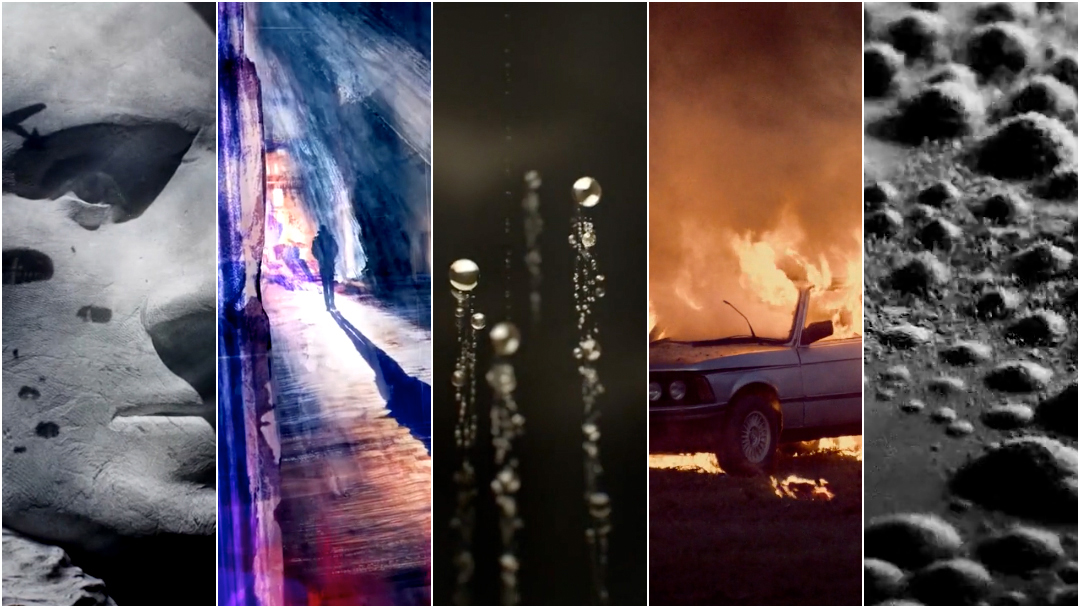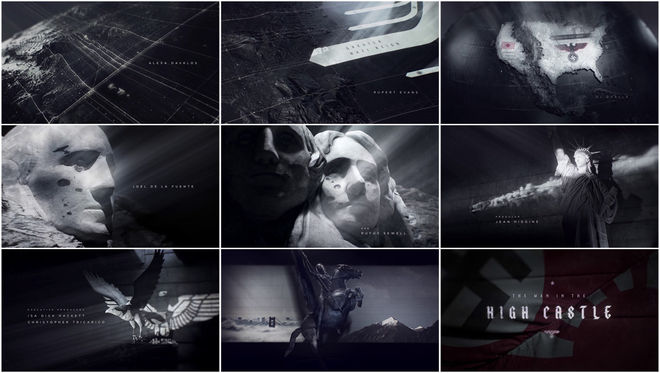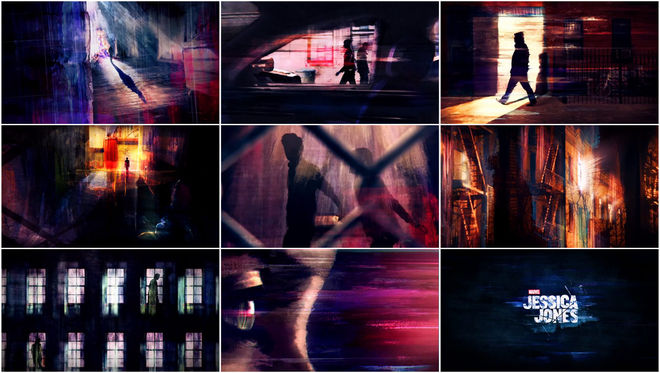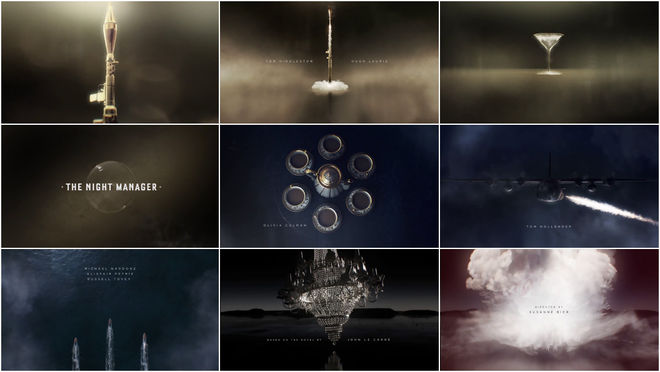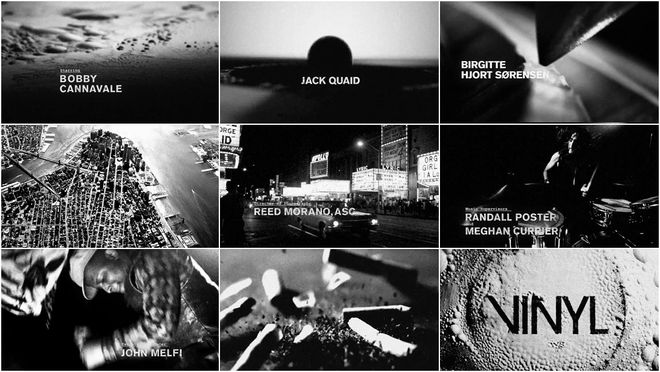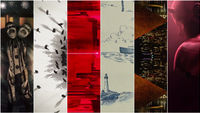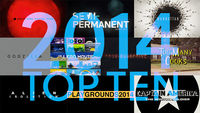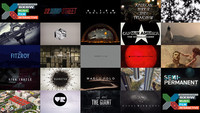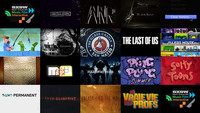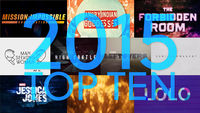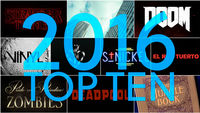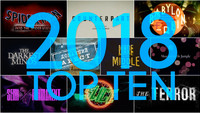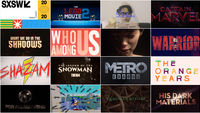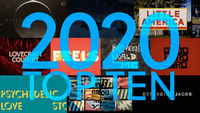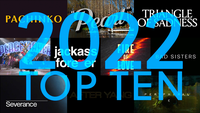09/12/2016 UPDATE:
Congratulations to Elastic on their Outstanding Main Title Design Emmy win for The Man in the High Castle and to composer Sean P. Callery for his Outstanding Original Main Title Theme Music award for Marvel’s Jessica Jones.
Elastic previously received the Emmy in Outstanding Main Title Design for their work on Game of Thrones and True Detective. Callery was previously nominated for his work on Homeland and The Kennedys. Jessica Jones is his first win.
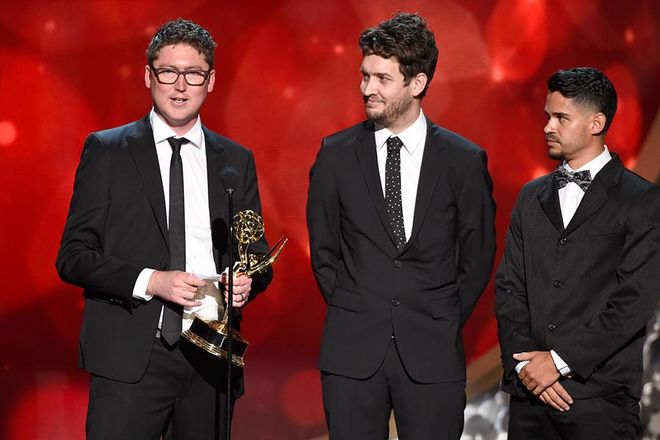
Patrick Clair, Raoul Marks, and Jose Limon of Elastic accept the Outstanding Main Title Design award at the 2016 Creative Arts Emmy Awards.
—
The 2016 Emmy nominations for Outstanding Main Title Design were announced on July 14th with industry stalwarts Imaginary Forces, Elastic, and Digital Kitchen taking home all of the nominations.
Studio Elastic continues its three-year nomination streak, earning nominations for the openings of Amazon’s The Man in the High Castle and AMC’s The Night Manager. Elastic previously won the title design Emmy in 2014 for True Detective and in 2011 for Game of Thrones.
This is also the third consecutive year in which Imaginary Forces received recognition for its title sequences. The studio, which took home the gold trophy last year for the Manhattan main titles, was nominated for its work on Netflix’s Jessica Jones and HBO’s Vinyl. IF was previously nominated for its work on Starz’s Black Sails and Magic City openings.
Elastic was also nominated in a new category, Outstanding Interactive Program, earning a nod for its immersive Game Of Thrones Main Titles 360 Experience, which was launched to coincide with the season six premiere. The experience is an interactive version of the epic fantasy’s main titles in which viewers can explore the map of Westeros as they see fit. It’s one of the first examples of an interactive TV main title, but with nearly 14 million views and a quarter of a million shares on Facebook alone it certainly won’t be the last.
Streaming services like Netflix and Amazon, which made inroads into the category last year with Marvel’s Daredevil and Bosch, respectively, dominated the title design category this year with three of the five total nominations. As predicted last year, the dominance of cable networks in this category has been shaken up. Expect to see this trend continue in the future.
Netflix also dominated in the Outstanding Original Main Title Theme Music category with three nominations: Sean P. Callery for Marvel’s Jessica Jones, Rodrigo Amarante for Narcos, and Tom Tykwer (director of Run Lola Run) for Sense8. The CW’s musical comedy Crazy Ex-Girlfriend, scored by Adam Schlesinger, and ABC’s The Whispers, scored by Robert Duncan, rounded out the nominations.
Imaginary Forces, Elastic, and Digital Kitchen have been powerhouses at the Primetime Emmys over the past decade or so – both in terms of wins and nominations. If this year’s Outstanding Main Title Design nods indicate anything, it’s that these studios are showing no signs of slowing down.
Watch all of the nominated sequences below, and then let us know your favourites.
—
THE MAN IN THE HIGH CASTLE
Amazon
Studio: Elastic
Creative Director: Patrick Clair
In Amazon’s The Man in the High Castle, an adaptation of Philip K. Dick’s alternate history novel of the same name, it’s 1962, the Allies lost World War II, and the two major Axis powers have divvied up North America between them. The narrative revolves around film canisters containing a revolutionary re-writing of history. That notion — of a dangerous film retelling history — is woven into the fabric of the show’s title sequence created by Elastic.
We move over a map of North America as monuments have combat footage projected on and through them. Lady Liberty, Joan of Arc, and the eagle blend together effortlessly to establish believable Nazi–American iconography. But the most poetically resonant choice made here is the use of “Edelweiss”. Ironically, this well-known “Austrian” song actually isn’t Austrian at all — it’s an American song, written by two Jewish songwriters (Rodgers and Hammerstein) for The Sound of Music in 1959. For an American to sing “Bless my homeland forever” in this alternate historical context is downright tragic. The key emotion conveyed by The Man in the High Castle’s title sequence is one of yearning, of doomed nostalgia, and the quiet struggle to maintain one’s identity in the face of huge forces.
Read our in-depth discussion with Creative Director Patrick Clair of Elastic.
*With notes from Ian Dawe
MARVEL'S JESSICA JONES
Netflix
Studio: Imaginary Forces
Creative Director: Michelle Dougherty
Get to know the darkest corners of Hell’s Kitchen through the eyes of Jessica Jones (Krysten Ritter), the titular superhero-turned-private-investigator — a hard-drinking, hard-hitting misfit whose troubled past has finally caught up with her. The line between private eye and voyeur slowly blurs as Jones haunts the rain-soaked streets, peering down alleyways and into foggy tenement windows, always watching, always being watched. Composer Sean Callery’s theme starts out slow and jazzy, but then takes on a frantic, frenzied dimension as her shadowy hunt continues — a hint of purple ever on the periphery.
Produced by Imaginary Forces with creative director Michelle Dougherty at the helm, the Jessica Jones title sequence stunningly transposes the distinctive painting style of Alias cover artist David W. Mack to set the stage for a complex and disturbing comic book yarn unlike anything Marvel has produced to date.
NARCOS
Netflix
Studio: Digital Kitchen
Creative Director: Tom O'Neill
It will be yours… It will be yours…
The solemn promise of Rodrigo Amarante’s “Tuyo” grounds Digital Kitchen’s pitch-perfect introduction to the Netflix crime saga Narcos. The title sequence is our passport into the sordid, seductive world of Colombian drug lord Pablo Escobar, offering a tantalizing glimpse at the life of the notorious “King of Cocaine” and a peek inside the international effort to bring down his multi-billion dollar enterprise. The opening is also the story of cocaine itself — the narcotic that built Escobar’s empire — and the wealth, power, glamour, violence, and death that always seems to accompany it. Hero to some, villain to many more, the effects of Escobar’s reign are still felt to this day, making the opening feel all the more relevant and vital.
Created by DK’s Los Angeles studio, the Narcos opener is a brilliant blend of past and present, combining archival photos and footage — some taken by Escobar’s actual family photographer “El Chino” — with a clean, sans-serif typeface and recreations of early ’80s espionage and excess. Capped off with stunning aerial shots of Bogotá and a portentous burning automobile, Amarante’s stirring ballad plays on, promising more and more and more.
Read our in-depth discussion with Creative Director Tom O’Neill of Digital Kitchen.
THE NIGHT MANAGER
AMC
Studio: Elastic
Creative Director: Patrick Clair
Since 1993, when John le Carré’s novel The Night Manager was first published, at least two film companies have tried and failed to bring this story of espionage and international arms dealing to the screen. Finally, in early 2015, it was announced that a new screen adaptation had gone into production, and this time it would give the story the time and format it required: a six-hour miniseries co-produced by BBC and AMC. Adapted by David Farr to take place in the present day and directed by Danish film director Susanne Bier, the serial revolves around a hotelier (Tom Hiddleston), who is recruited by British Intelligence to infiltrate the inner circle of an arms dealer (Hugh Laurie).
Elastic’s title sequence to the series is a beguiling gateway to a world of untouchable refinement, fluid and sharp. Nothing is what it seems, and everything shifts its shape. The movements are sleek and cold, precise and seductive. A gilded rocket launcher becomes the stem of a martini glass, an array of teacups transforms into the barrels of a rotary cannon, diamonds are bombs, ships are champagne bubbles. By the time the title sequence is finished, the stage is set for a tale of spycraft and betrayal.
Read more about The Night Manager title sequence on Motionographer.
VINYL
HBO
Studio: Imaginary Forces
Creative Directors: Alan Williams, Michelle Dougherty
Do you remember the best concert you ever went to? You know, the one where your favourite band brought down the house and you partied harder than you ever have before or since? If you’ve ever had an experience like that then you will most certainly recognize the vein being tapped into by the raw and rollicking opening to HBO’s Vinyl.
A new music drama from the venerable cable channel, Vinyl centers on record executive Richie Finestra (Bobby Cannavale), a ticking time bomb of a man subsisting on a steady diet of booze, cocaine, and rage, desperately trying to save his label by signing the next big thing. Co-created by the dream team of Mick Jagger, Martin Scorsese, Rich Cohen, and Terence Winter, the series shines light on one of the most exciting and insane eras in music history: the early 1970s in New York City. It was a time ruled by rock stars and record men, a place where proto-punk and primordial hip hop were birthed within earshot of psychedelic soul and stadium glam rock.
To create Vinyl’s opening title sequence, the producers enlisted studio Imaginary Forces to channel Richie’s depraved essence and capture the zeitgeist of ‘70s NYC. A team working in both New York and Los Angeles brought together numerous concepts — including high-speed and macro photography — to create a minute and a half of blisteringly intense, hard rockin’ title design. From the moment the stylus needle first tears into the LP’s groove to rocker Sturgill Simpson’s final venue-demolishing scream, the Vinyl sequence is turned up to eleven throughout, still reverberating in your chest as the show begins. Forget the encore, give us that opening act again.
—
Check back on September 11th to find out which sequences take home a prize at the 68th Creative Arts Emmy Awards. And in the meantime, be sure to read our Top 10 Title Sequences of 2015 feature to see more of the best title design work of the last year.
THE MAN IN THE HIGH CASTLE
Amazon
Studio: Elastic
Creative Director: Patrick Clair
Producer: Jamie McBriety
Lead Animator & Compositor: Raoul Marks
Designers: Paul Kim, Kevin Heo, Sam Cividanis
CG Modeler: Jose Limon
Executive Producer: Jennifer Sofio Hall
Music: “Edelweiss” performed by Jeanette Olsson
—
MARVEL'S JESSICA JONES
Netflix
Studio: Imaginary Forces
Creative Director: Michelle Dougherty
Executive Producer: Ben Apley
Producer: Keith Bryant
Lead Designer: Arisu Kashiwagi
Designers: Joan Lau, Robin Roepstorff, Joseph Ahn,
Wes Yang, Kris Fortin, Charles Khoury
Design Intern: Jacob Ferguson
Illustrators: David Mack, Arisu Kashiwagi
Storyboards: Alejandro Lee
Lead Animators: Thomas McMahan, Eric Demeusy
Editor: Michael Radtke, Danielle White
Flame Artist: Rod Basham
Director of Photography: Dan Kanes
Photographers: Sean Dougherty, Sidney Prawatyotin
Coordinator: Nicole Zschiesche
Music: Sean Callery
—
NARCOS
Netflix
Studio: Digital Kitchen
Client: Gaumont International/Netflix
Creative Director: Tom O’Neill
Production Designer: Harshit Desai
Lead Animator/Compositor: David Badounts
CG/Design Lead: Joshua Smith
Editor: Nik Kleverov
Producer: Paul Makowski
Live Action Producer: Chad Stanley
Executive Producer: Cynthia Biamon
Executive Producer: Erica Coates
Music: Pedro Bromfman
Song: “Tuyo” by Rodrigo Amarante
—
Studio: Elastic
Director: Patrick Clair
Designers: Paul Kim, Jeff Han, Kevin Heo, Felix Soletic, Nick Miller
Lead Animator: Raoul Marks
Animators: Youngsub Song, Lucy Kim
Producer: Zach Wakefield
Pitch Producer: Carol Collins
Coordinator: Danny Hirsch
Head of Production: Kim Christensen
Executive Producer: Jennifer Sofio Hall
Special Thanks: Angus Wall
Music: Víctor Reyes
—
VINYL
HBO
Studio: Imaginary Forces
Executive Creative Director: Peter Frankfurt
Creative Directors: Alan Williams, Michelle Dougherty
Executive Producer: Jon Hassell
Lead Producer: Tess Sitzmann
Producer: Dunja Vitolic
Lead Editor: Jessica Ledoux
Editor: Zach Kilroy
Type Designers: Jeremy Cox, Henry Chang
3D Animators: Bhakti Patel, Dan Meehan, Sekani Solomon
Coordinator: Krista Templeton
Additional Designs: Nick Wiesner, Michael Sistek
Type Animations: Dan Meehan, Henry Chang
Music: “Sugar Daddy” by Sturgill Simpson

